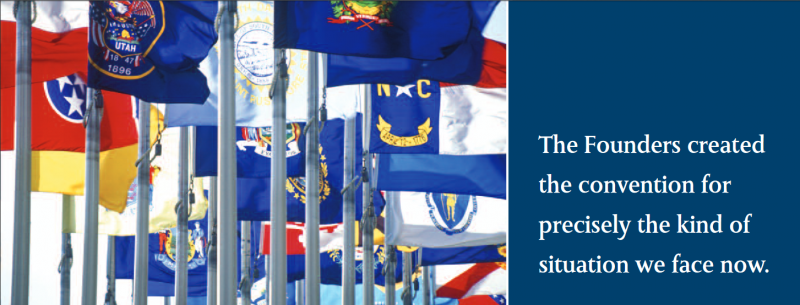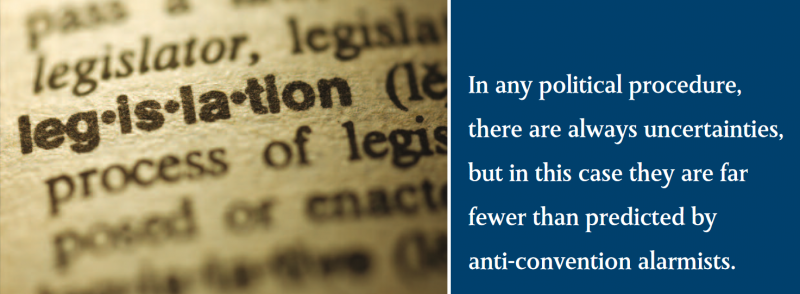Article 7 - The Myth of a Runaway Amendments Convention
The Myth of a Runaway Amendments Convention
Robert Natelson, Independence Institute’s Senior Fellow in Constitutional Jurisprudence and Head of the Institute’s Article V Information Center
The Founders bequeathed to Americans a method to bypass the federal government and amend the Constitution, empowering two-thirds of the states to call an amendments convention. In the wake of Mark Levin’s bestselling book, The Liberty Amendments, proposing just such a convention, some have raised entirely unnecessary alarms. Surprisingly, a few of the leading lights of conservatism have been among the alarmists. But their concerns are based on an incomplete reading of history and judicial case law.
Phyllis Schlafly is a great American and a great leader, but her speculations about the nature of the Constitution’s “convention for proposing amendments” are nearly as quaint as Dante’s speculations about the solar system. Those speculations simply overlook the last three decades of research into the background and subsequent history of the Constitution’s amendment process. They also ignore how that process actually works, and how the courts elucidate it.
Article V of the Constitution provides for a “convention for proposing amendments.” The Founders inserted this provision to enable the people, acting through their state legislatures, to rein in an abusive or runaway federal government. In other words, the Founders created the convention for precisely the kind of situation we face now.
Mrs. Schlafly doesn’t think we know much else about the process. She writes, “Everything else about how an Article V Convention would function, including its agenda, is anybody’s guess.”
But she’s wrong. There is no need to guess. There is a great deal we know about the subject.
The “convention for proposing amendments” was consciously modeled on federal conventions held during the century leading up to the Constitutional Convention. During this period the states — and before Independence, the colonies — met together on average about every 40 months. These were meetings of separate governments, and their protocols were based on international practice. Those protocols were well-established and are inherent in Article V.
Each federal convention has been called to address one or more discrete, prescribed problems. A convention “call” cannot determine how many delegates (“commissioners”) each state sends or how they are chosen. That is a matter for each state legislature to decide.
A convention for proposing amendments is a meeting of sovereignties or semi-sovereignties, and each state has one vote. Each state com-missioner is empowered and instructed by his or her state legislature or its designee.
As was true of earlier interstate gatherings, the convention for proposing amendments is called to propose solutions to discrete, preassigned problems. There is no record of any federal convention significantly exceeding its preassigned mandate — not even the Constitutional Convention, despite erroneous claims to the contrary.
The state legislatures’ applications fix the subject-matter for a convention for proposing amendments. When two-thirds of the states apply on a given subject, Congress must call the convention. However, the congressional call is limited to the time and place of meeting, and to reciting the state-determined subject.
In the unlikely event that the convention strays from its prescribed agenda (and the commissioners escape recall), any “proposal” they issue is ultra vires (“beyond powers”) and void. Congress may not choose a “mode of ratification” for that proposal, and the necessary three-quarters of the states would not ratify it in any event.
Contrary to Mrs. Schlafly’s claim that “Article V doesn’t give any power to the courts to correct what does or does not happen,” the courts can and do adjudicate Article V cases. There has been a long line of those cases from 1798 into the 21st century.
“But,” you might ask, “Will the prescribed convention procedures actually work?“
They already have. In 1861, in an effort to prevent the Civil War, the Virginia legislature called for an interstate gathering formally entitled the Washington Conference Convention and, informally, the Washington Peace Conference. The idea was that the convention would draft and propose one or more constitutional amendments that, if ratified, would weaken extremists in both the North and the South, and thereby save the Union. This gathering differed from an Article V convention primarily in that it made its proposal to Congress rather than to the states. In virtually every other respect, however, it was a blueprint for an Article V convention.
When the convention met in Washington, D.C., on February 4, 1861, seven states already had seceded. Of the 26 then remaining in the Union, 21 sent committees (delegations). The conference lasted until February 27, when it proposed a 7-section constitutional amendment.
The assembly followed to the letter the convention rules established during the 18th century—the same rules relied on by the Constitution’s Framers when they provided for a Convention for Proposing Amendments. Specifically:
- The convention call fixed the place, time, and topic, but did not try to dictate other matters, such as selection of commissioners (delegates) or convention rules.
- At the convention, voting was by state. One vote was, apparently inadvertently, taken per capita, but that was quickly corrected.
- The committee from each state was selected in the manner that state’s legislature directed.
- The conclave adopted its own rules and selected its own officers. Former President John Tyler served as president.
- The commissioners stayed on topic. One commissioner made a motion that was arguably off topic (changing the President’s term of office), but that was voted down without debate.
Congress subsequently deadlocked over the amendment, but the convention itself did everything right: It followed all the protocols listed above, and it produced a compromise amendment. Although the convention met in a time of enormous stress, this “dry run” came off well, with none of Mrs. Schlafly’s speculative “horribles.”
In any political procedure, there are always uncertainties, but in this case they are far fewer than predicted by anti-convention alarmists. And they must be balanced against a certainty: Unless we use the procedure the Founders gave us to rein in a runaway Congress, then Congress will surely continue to run away.



